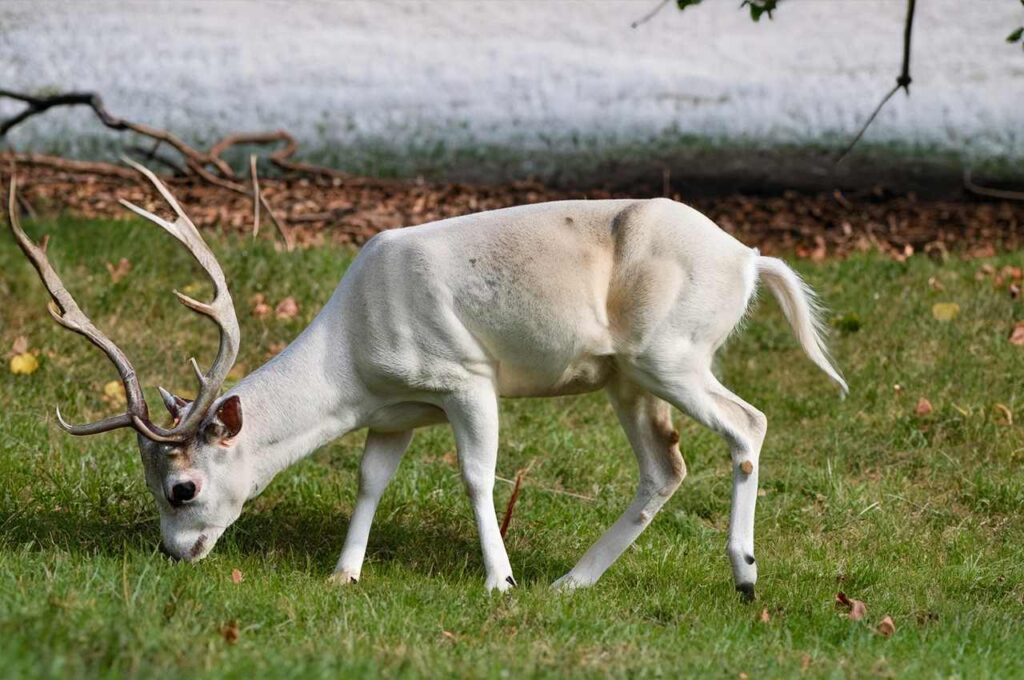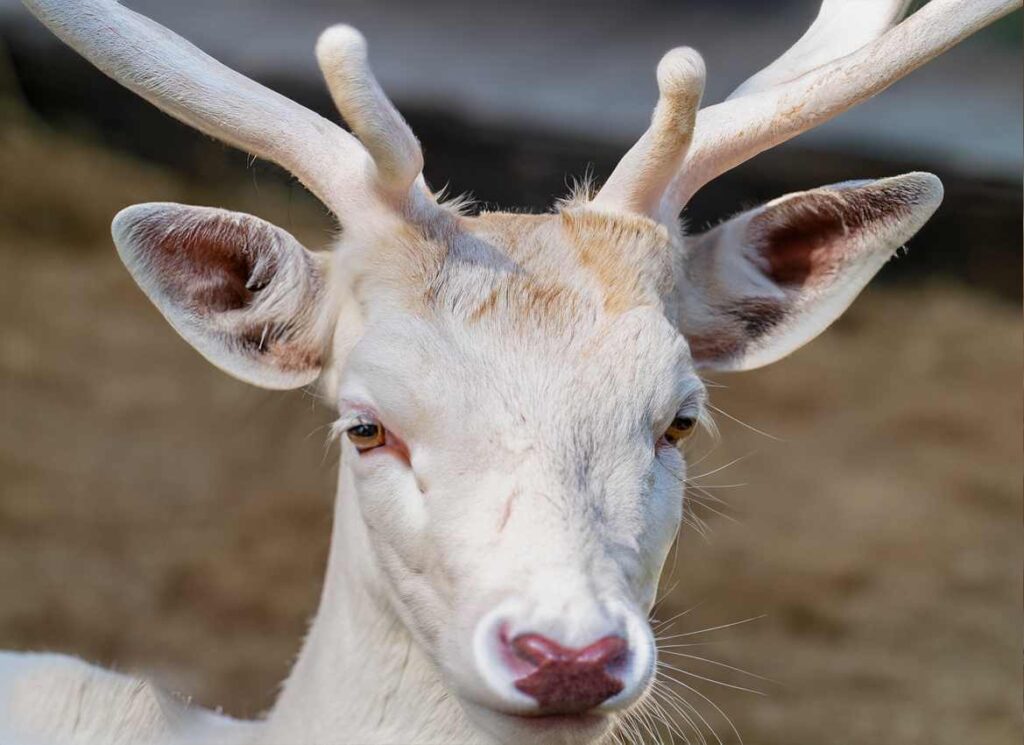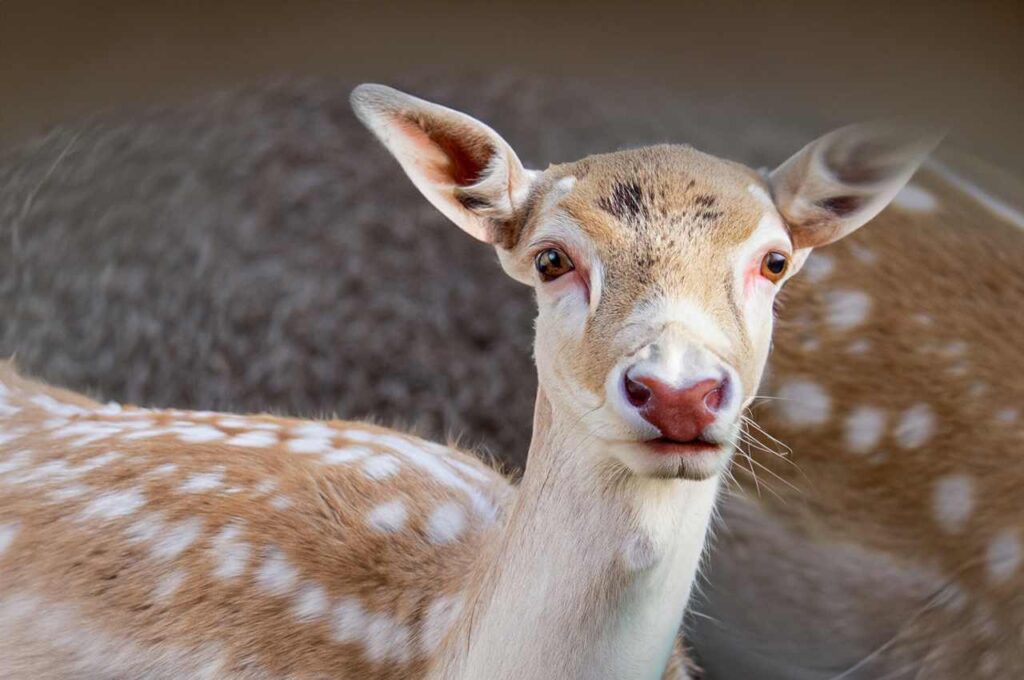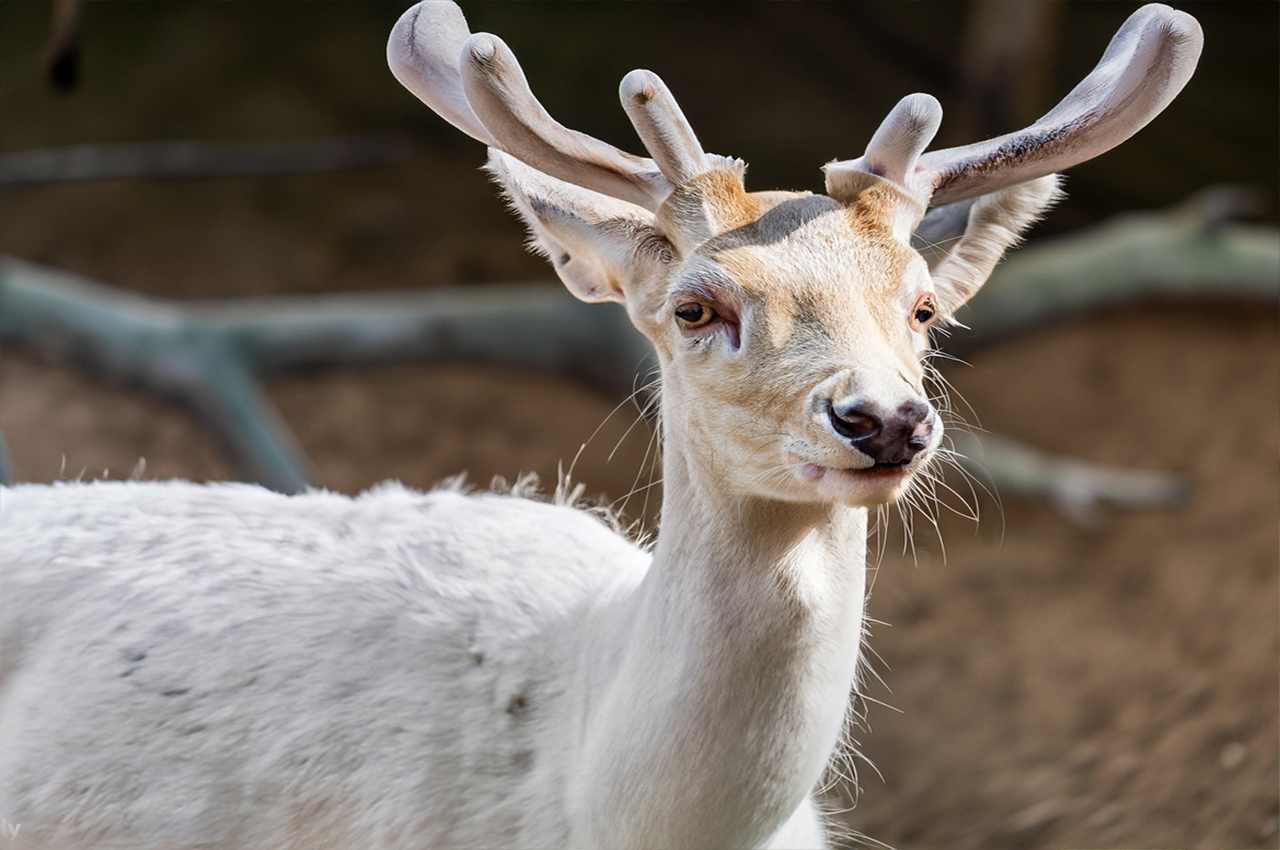What is a leucistic deer, and how does it differ from albino and piebald deer? On rare instances, you could come across a spectacular sight that strikes your mind while you go through the countryside or drive through rural landscapes—a white deer. Leucistic deer are ethereal animals who are sometimes confused with their elusive albino cousins. The fascinating world of leucistic deer will be uncovered in this thorough investigation, along with information on their distinctive traits, how they vary from actual albinos, and the myths and realities that surround them.
What is a Leucistic Deer?
A leucistic deer is a deer that has a partial loss of pigmentation in its coat, resulting in white, pale, or patchy coloration. A genetic abnormality called leucism affects how much melanin, the pigment that gives skin, hair, and eyes their color, is produced. Deer that are leucistic may have a few tiny spots of white on their body or may be almost totally white. Their hooves may be white or transparent, but their eyes and nose are typically of normal hue.
Leucism is distinct from albinism, which manifests as a total absence of melanin synthesis. Deer with albinism have pink noses, pink eyes, and white fur. Piebaldism, a condition in which deer have black and white spots, is distinct from leucism. Deer with piebald coats also have typical-colored eyes and nostrils.
Leucistic deer may have a poorer survival rate than deer with normal pigmentation because leucism might make them more conspicuous to predators. Leucistic deer, however, are also really lovely and distinctive, and nature lovers often like them.
Although they are relatively uncommon, leucistic deer may be found anywhere in the globe. Although they have been documented in other deer species, including mule deer and elk, they are most often found in populations of white-tailed deer.
It’s crucial to respect a leucistic deer’s space and refrain from bothering it if you spot one. Deer with leucistic conditions should be handled carefully since they are wild creatures.

Types of Genetic Traits in Deer
| Genetic Trait | Description | Prevalence |
|---|---|---|
| Leucism | Lack of pigmentation in skin or fur | About 1% |
| Albino | Complete absence of melanin pigment in the entire body | Extremely rare |
| Piebaldism | Partial lack of pigmentation resulting in white splotches | More common than leucism |
| Melanism | Excessive melanin pigment, resulting in a dark coat | Extremely rare |
Leucism vs. Albinism: Understanding the Difference
Contrary to popular opinion, seeing a pure albino deer in the wild is quite uncommon. With pink eyes and an all-white appearance due to the lack of pigment, albinism is a congenital disease. Albino species, such as deer, have a low survival rate because of their poor vision and conspicuousness. Leucism, a recessive genetic condition, on the other hand, is the characteristic that causes the majority of reports of white deer sightings. Deer that are leucistic maintain their typical eye color, which is typically brown, and are not visually impaired. Let’s look at the main variations between these two situations:
Differences Between Leucistic and Albino Deer
| Characteristic | Leucistic Deer | Albino Deer |
|---|---|---|
| Pigmentation in Coat | Partially or completely white | Completely white |
| Eye Color | Brown | Pink or red |
| Pigmentation in Eyes | Present | Lacking melanin pigment |
| Eye Sight | Typically normal | Often impaired |
| Prevalence in Wild | Rare (about 1 in 25,000) | Extremely rare |
| Examples | White deer with white spots | Completely white deer |
Despite having fairly similar outward appearances, leucism and albinism vary significantly:
- Eyes – Due to a lack of pigment, albino deer have pink or blue eyes. Deer with leukemia have typical, dark eyes.
- Skin and Hooves – The skin and hooves of an albino deer have a pinkish-white color. Under its white coat, a leucistic deer has black skin.
- Genetics – A recessive gene is the genetic cause of albinism. A dominant gene is responsible for leucism.
- Rarity – Only 1 in 100,000 deer are albino, making them exceptionally uncommon. At 1 in 20,000, leucistic deer are more prevalent.
- Survival – Due to their poor vision and lack of concealment, albino deer seldom survive for an extended period of time. Leucistic deer have a higher chance of surviving with normal eyesight and some concealment.
In the end, an albino deer has white fur with pink eyes, but a leucistic deer has white fur with black eyes and a nose.
Piebaldism vs. Leucism: An Interesting Difference
Deer with prominent white spots on their coats often result from piebaldism, another remarkable genetic feature. Inaccurately referred to be partly albino, these piebald deer. To distinguish leucism from piebaldism:
- Leucistic deer have noses and eyes that are either completely black or their original color, and they might be partially or completely white. Visual disabilities are uncommon.
- Piebald Deer: Piebald deer have white splotches on their coats that often stand out sharply from their brown patches. They don’t have vision problems, and their eyes and nose still have their usual colors.
The Dark Side of Genetics: Leucism vs. Melanism
Leucism has a polar opposite in the world of deer genetics called melanism. Melanistic deer have a genetic abnormality that causes an increase in melanin synthesis, which darkens their whole coat. These deer are similarly uncommon and extremely spectacular, with a nearly-black coat. Melanism is a genetic mutation that may happen in different animal species, much as leucism and albinism. The black panther, which is really a leopard or jaguar with melanism, is a well-known illustration.
The Elusiveness of Leucistic Deer
Leucistic deer are very uncommon jewels in the animal realm, making up just around 1% of the deer population (or about 1 in 25,000 individuals). It’s important to understand that leucism may appear in a variety of deer species and is not exclusive to any one species. Leucism ranges in intensity, resulting in three broad categories:

1. Partial Leucism: Leucistic deer in this type have white patches on otherwise normal coats, which is a startling contrast.
2. Full Leucism: Fully leucistic deer are very alluring due to their all-white coats, which set them apart from their animal counterparts.
3. Piebald Deer: Although not completely leucistic, piebald deer have a distinctive combination of white and brown patches, leading to frequent confusion with partly albino deer.
What is Leucism?
A hereditary disorder called leucism causes a partial lack of pigmentation. Leucism just lowers melanin levels, as opposed to albinism, which results in a total absence of melanin. As a result, leucistic animals retain some colour but seem considerably paler than usual.

The Odd Relationship Between Hunting and Leucistic Deer
Leucistic deer hunting laws vary significantly based on where you live and the level of local wildlife protection. To safeguard these unusual species, strict laws have been put in place in certain places. However, a lot of hunters respect leucistic deer and decide not to hunt them. This awe is often based on myths and notions about the repercussions of shooting white deer.
The Myths Surrounding White Deer
Since ancient times, white deer have fascinated and mystified mankind. Numerous tales and stories have been created as a result of their ghostly appearance, many of which give these animals unique importance. Native societies and hunters often regard them as holy and avoid hunting them. According to a widely held myth, hunters who kill a white deer will be cursed with bad luck and may find it difficult to successfully hunt another deer in the future.
The Mysterious Residents of the Seneca Army Depot
In the Seneca Army Depot in New York, one of the most well-known populations of leucistic deer may be discovered. Established in the 1940s, this gated reserve has evolved into a haven for white-tailed deer, including some that are leucistic. These unusual deer have flourished thanks to tight hunting laws, isolation from the outside world, and habitat preservation. Currently, it has one of the highest densities of leucistic deer anywhere in the world, with 200–300 of the 800 whitetail deer on the farm showing leucism.
| Time Period | Event |
|---|---|
| 1940s | Establishment of military base in Seneca Falls |
| 1951 | Depot commander establishes rule protecting white deer |
| Present | Seneca White Deer herd has highest rate of leucism |
Leucistic Deer: What the Future Holds
It is crucial to acknowledge the rarity and importance of leucistic deer in both the natural world and the world of myth and superstition as we think about the survival of these animals and their distinctive habitats. Ongoing efforts to safeguard and conserve these amazing animals serve as a reminder of the rich diversity of life on our planet.
In conclusion, leucistic deer continue to pique people’s curiosity because of their alluring look and fascinating genetics. Their existence in the natural world highlights the wonders of biodiversity and the everlasting human interest with the secrets of nature, whether they are seen as uncommon oddities or worshipped as holy entities.
Frequently Asked Questions
What is the difference between albino and leucistic deer?
Albino and leucistic deer vary mostly in color. White splotches, a half-brown and half-white look, or practically all white, with black noses and unaffected vision, characterize leucistic deer. Albino deer are white with pink eyes, noses, and hooves because they lack bodily color. Only a few albino deer survive in the wild because to their weak vision and brightness. Mixed brown and white piebald deer are commonly mistaken for leucistic deer.
How common is leucism in deer?
Leucism affects just 1% of white-tailed deer. Leucism, a hereditary disease that causes partial pigmentation loss, causes deer to have white splotches or be half brown and half white. Their noses are black like deer, and their vision is normally fine. Due to poor vision and visibility, real albino deer, which are full white with pink eyes, nose, and hooves, are uncommon and seldom survive in the wild. Piebald deer, which have brown and white patches, are more prevalent than albino or leucistic deer and occur in around one in 1,000 deer, with greater rates in certain areas.
What is the difference between piebald and leucistic deer?
White and albino deer vary mostly in coloring and genetics. Leucistic deer, or white deer, have varied degrees of white skin but pigmented noses and eyes. Because they lack the pigmentation gene, albino deer are completely white with pink eyes, noses, and hooves. Albino deer are uncommon and short-lived. Piebald deer are brown-white mixed deer, neither leucistic or albino.
What is the difference between a white deer and an albino deer?
White and albino deer vary mostly in coloring and genetics. Leucistic deer, or white deer, have varied degrees of white skin but pigmented noses and eyes. Because they lack the pigmentation gene, albino deer are completely white with pink eyes, noses, and hooves. Albino deer are uncommon and short-lived. Piebald deer are brown-white mixed deer, neither leucistic or albino.
Are leucistic deer blind?
Leucistic deer have colored eyes but normal vision, unlike albino deer. A hereditary disorder that causes partial pigmentation loss causes leucism, which causes variable degrees of white skin while keeping vision. Albino deer have pink eyes and no body pigment, which might impair vision. Therefore, leucistic deer are not blind owing to genetics.
Are leucistic deers deaf?
No evidence suggests leucistic deer are deaf. Animals with leucism have pigmentation issues but not hearing problems. Leucistic deer may have white splotches or partial white coats, but their hearing and vision are normally undamaged. LUCistic deer may struggle to survive in the wild owing of their diminished camouflage, which makes them more conspicuous to predators.
What causes leucistic?
Genetics produce leucism, which causes animals to lose pigmentation in their skin, hair, feathers, scales, and coats. This disorder is caused by pigment cell migration abnormalities from the neural crest to the animal’s exterior characteristics during growth. Leucism may afflict birds, mammals, reptiles, amphibians, and fish via genetic changes. Due to neural crest diseases that do not influence eye pigmentation, leucistic animals have naturally colored eyes.
Is leucism harmful?
Leucism does not hurt animals, although it may affect their survivability in the wild. Leucistic animals may have camouflage or mate attraction concerns, but they do not have health issues like albino animals. Lack of pigment in leucistic animals may impact thermoregulation, which might be problematic for solar-heated species. Depending on each species’ ecological and behavioral characteristics, leucism might affect animal survival.
Are leucistic deer rare?
About 1% of white-tailed deer are leucistic. Their lack of camouflage makes them more exposed to predators in the wild, contributing to their scarcity. Albinos are uncommon, with less than 2% of white-tailed deer having piebald features and even fewer genuine albinos. Albino deer have pink eyes, noses, and hooves with no body colour. In the wild, albino animals have a lower survival rate. Piebald deer, which have patches of white hair, are more frequent than albino or leucistic deer but still unusual.
Is leucistic deer rarer than albino?
Leucistic deer are rarer than albino. About 1% of white-tailed deer are leucistic, whereas albino and genuine albino deer are rarer, accounting for less than 2%. Despite being uncommon, piebald deer are more prevalent than albino and leucistic deer.
Where do leucistic deer live?
Leucistic deer can be found in various habitats where white-tailed deer are present, such as forests, fields, and grasslands. It’s vital to understand that leucistic deer are really white-tailed deer with a genetic disease that causes partial pigmentation loss, not a different species. They may have difficulties surviving in the wild because of their unusual white or patchy appearance, which may make them more noticeable to predators. Even though they are very uncommon, Seneca Falls, New York, is home to a sizable population of leucistic deer. Albino deer, on the other hand, are much more scarce and may be found in comparable settings but are very rare in the wild.
Conclusion
White deer, who have the genetic mutation known as leucism, are fascinating animals that may be found all over the globe, although their natural habitats are mostly in North America and Europe. White deer are generally more regularly seen in the eastern United States, Canada, the United Kingdom, Ireland, and Sweden, while they are also sometimes seen in South America, Asia, and Australia. Instead of being a different deer species, these unusual animals show a dramatic decrease in melanin synthesis, giving them a whitish, pale, or patchy look. White deer are particularly revered in several cultures and are often seen as representations of harmony, purity, and wealth. It’s important to use care and respect these amazing animals’ untamed nature when you come across them, giving them the room and tranquility they need.
- California Deer Hunting Guide: Seasons, Rules, Permits, and More - 26 June 2024
- Arkansas Deer Season 2024 [Schedules, Licenses, Bag Limits & More!] - 26 June 2024
- 2024 Arizona Deer Season New Dates & Rules! - 25 June 2024




